The first Thursday of every August has been celebrated (since circa 2011-12) as National IPA Day. While it seems there are many, many beer related holidays to celebrate (some might argue there are too many – we won’t, but some might, I guess), this beer holiday is a bit more near and dear to us since we make so much IPA at our brewery. By and large, most of the IPA we make goes by the name of a single brand: Hayburner, our flagship American IPA.
And so, on National IPA Day, we thought we’d take a moment to tell the story of the brief history of Hayburner.
In the early days of homebrewing, Corey and Matt steered away from using hops a bit, and instead focused on lagers, German and Belgian styles, malty beers like amber ales and stouts, and fruit beers. In fact, the first IPA they ever homebrewed was actually a black IPA (ha) with smoked malt in it. (That beer later became known as Last Blacksmith).
Part of our aversion to brewing IPAs at that time (this was in 2011-2012) was that IPAs were so bitter. We felt then, as we do now, that while a little bit of bitterness can provide balance to beer, too much bitterness destroys flavor, and we always aimed to make fully flavored beers.
Our opinion of IPAs changed the first time we drank Heady Topper via the Alchemist. Heady Topper, for a long period of time, was known as the best beer in the world (and I am sure there are many who still believe it to be so, and I wouldn’t argue with them). Heady Topper was also undoubtedly the godfather of the “New England IPA” style – unfiltered, light on specialty malt, low on bitterness, high on aroma and flavor.
The first time Corey and I split a Heady Topper, we were really impressed with its drinkability, even at 8% double IPA strength. Today, these are still our favorite types of beers, and the beers we make the most of: high on flavor, high on drinkability.
With our IPA excitement brimming, we worked on a recipe that used less specialty malt, lots of hop flavor additions via late kettle hopping, with a substantial dry hop addition. Seeking feedback on our IPA recipe, we submitted bottles from the second batch of IPA we ever made to the Amber Waves of Grain homebrewing competition in 2013 and came away with a gold medal for best IPA! It was the first medal we ever won, and we were incredibly thrilled. We started thinking we were onto something.
Around the time we were planning our brewery, there was a national hop shortage, which made many varieties of hops difficult to obtain. The early hombrewed versions of our IPA had Citra and Centennial hops – but when we were investigating purchasing these hops to use in our production brewery, they were nowhere to be found.
We wound up making some critical hop substitutions to ensure we could obtain the necessary hops for our IPA. Citra was replaced with Falconers Flight, which is a proprietary blend of hops made by Yakima Chief Hops. FF contains Citra, Simcoe, and a few other hops. We found FF worked really well as a dry hop. We initially replaced the Centennial hop (which was extremely popular at the time, since it was being used exclusively in fantastic beers like Two Hearted by Bells and also in Founders Centennial IPA) with a hop blend called “Centennial-type” – which was really just a blend of Cascade and Columbus hops. We later replaced the “Centennial-type” with Cascade and Columbus hops, which were easy to obtain, and Hayburner still contains these two hops today.
Finally, we wanted to add our own unique spin on our recipe by adding a new and fairly unexplored hop variety. After some research, we settled on a hop called Glacier. Neither Corey nor Matt had ever had a beer containing Glacier before, but we knew that it was available, and after some research and experimentation, found that it gave beers a peachy / stone fruit flavor with some earthy character. It fit really well with the profile of the beer we were going for so we decided to adopt it for our recipe. In fact, original versions of the beer, including the version we won the gold medal for, was called “Glacier IPA”.
The name Hayburner was Corey’s idea. For those who don’t know, the mules that towed boats along the side of the canal were nicknamed hayburners. Back then, we wondered (somewhat hilariously) if the name Hayburner might be too edgy, haha. The iconic angry kicking mule logo was introduced in 2016 when we first started canning Hayburner.
The Haybuner recipe changed a lot over the years. While Hayburner was always very aromatic and drinkable, early versions made at our brewery in 2014-15 were more bitter, had a bit more malt character, and were a lot clearer in appearance. Before hazy / turbid IPAs were a thing, people expected IPAs to be clear. We once had a customer complain because a keg of Hayburner was too hazy. We don’t hear many complaints for that today!
According to our records, we’ve changed the Hayburner recipe at least 151 times as of this post. This is all in the name of continual improvement. We taste every batch of Hayburner before packaging and are always thinking of ways to make it even better. In fact, we did make an important change to the Hayburner recipe recently. As it turns out, the Glacier hop, which we selected at the time because no one else was using it, is literally used by no one else in the country any more. Hop farms don’t even don’t want to grow it. As a result, we’ve recently changed the recipe to replace Glacier with Azacca hops. Azacca is a touch more tropical and woody than Glacier, but the flavor and aroma is the same as it’s always been: luscious and citrusy, with primary notes of orange, melon, grapefruit, and a slightly earthy finish, with firm bitterness and a soft, airy malt base.
We never expected Hayburner to be our best-selling beer, and we certainly never expected to make as much of it as we currently make. We’re flattered that so many Western New Yorkers think of Hayburner first when they think of IPAs. Thanks for the support over the years, and we hope you enjoy a Hayburner today on National IPA Day. Cheers!









